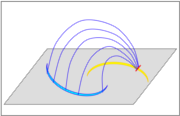
One of the most intriguing results obtained by the EUV Imaging Spectrometer (EIS) is the discovery of ubiquitous hot plasma outflows seen in all active regions (hereafter, ARs). These outflows have blueshifted line-of-sight velocities that typically range from a few to 50 km s-1 (for, e.g. FeXII, see Harra et al. (2008); Del Zanna (2008) and reference therein), and persist for at least several days. They are most prominent at the AR boundary, and appear over monopolar magnetic areas. Figure 1, showing the EIS/FeXII image and the relative Doppler map of AR 10942, provides an example of such outflows.
The work presented here is based on the observation that such outflows are concentrated at boundaries that mark the change in magnetic topology from "open" to closed field, or appear over a monopolar area between loops connecting to different regions of opposite polarity. Such locations are called quasi-separatrix layers (QSL, see Démoulin (2007) for a review on QSL, Animation 1, and the numerical details). QSLs are preferential locations for current layer development and magnetic reconnection. At QSLs, field lines continuously slip across each other during the reconnection process, leading to successive rearrangements of the connections between neighboring field lines along the QSLs, as was shown by MHD simulations (Aulanier et al. (2006)) and inferred from Hinode XRT observations (Aulanier et al. (2007)).
Figure 2 shows the linear force-free field (LFFF) and the QSL traces at the photosphere (see numerical details for the respective methods of computation). There is a global agreement between the coronal magnetic field model and the XRT observations on one hand (cf. left panel in Figure 2), and the EIS FeXII intensity map on the other (cf. left panel of Figure 1). The most extended QSL (labeled as a in the right panel of Figure 2) is located over the following positive polarity of the AR (eastern side) where we see the strongest outflows in the EIS observation on February 20 at 23:45 UT (Figure 1). This is clearly shown in the overlay image in Figure 3, where strong AR blue-shifted outflows overlap with the "open" field lines computed from the western side of the QSL located over the positive polarity (cf. also Figure 1, right panel). The "open" field lines are field lines connecting either to solar wind, or have long connections outside the AR.
Another major QSL (labeled as d in the right panel of Figure 2) is found over the leading negative polarity and is associated with outflows visible in the EIS velocity map in Figure 4 (data are from February 21 due to not optimal overlap of coverage between MDI and EIS). The QSL separates short field lines (green, connecting the main polarity to network-like polarities) from "open" ones (pink). Similarly, the blue and orange field lines are analogous to those found in Figures 3, showing again that the blueshifts are mainly found along "open" field lines located in the vicinity of the QSL.
To complement the EIS FeXII observations, data in the cooler SiVII spectral line are analyzed. This allows a closer comparison of outflows with the calculated QSLs as the emission comes from a less spatially extended region, determining in this way which section of the QSL is related to the strong coronal outflows. We found that a narrow blueshifted outflow lane is present along some QSLs in the lowest temperature SiVII velocity map. The outflow area is larger in hotter FeX and even larger in FeXII, indicating that the outflows fan out and accelerate with height (Figure 5). The base of the blueshifted outflows were further constrained by redshifted downflows seen in the SiVII velocity map bearing strong resemblance to the pattern of upflows observed in the higher-temperature Fe lines, while being not entirely cospatial with them. We interpreted these redshifted structures as cooling plasma flows along loops of previous hot upflows. Since the redshifted loop-like features appeared to converge toward the QSL, most of them ending in its vicinity, they provided further evidence that the outflows do originate from the vicinity of QSLs and fan out with height.
QSLs (including separatrices) naturally explain the most puzzling characteristic of blueshifted outflow regions which is their occurrence over monopolar areas. Here the sharp boundaries found in Doppler velocity maps between blue and redshifted features mark the change in magnetic topology from "open" or large-scale to closed field. The longevity of the outflows can be explained by the very nature of QSLs, since the latter are defined by the global properties of the magnetic configuration which evolves slowly. As for the mechanism accelerating the plasma, outflows are expected in the vicinity of such QSLs where reconnection can transform closed loops into "open" field or large-scale loops. The dense plasma of the initial closed loop is no longer confined along the reconnected magnetic field and is accelerated by a plasma pressure gradient and a magnetic tension force. However, the QSL scenario that we have described is compatible also with other outflow mechanisms that have been proposed (see, e.g., Doschek et al. (2007), Hara et al. (2008), Del Zanna (2008)).
This work has been published in the Astropysical Journal, see: Baker et al. (2009)| @ |

|
T. Török, L. Van Driel, G. Valori, J.-M. Malherbe (Obs Paris) in collaboration with KU Leuven, HVAR, UNIGRAZ, UGOE |

|

|

|






